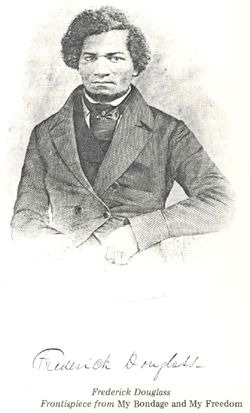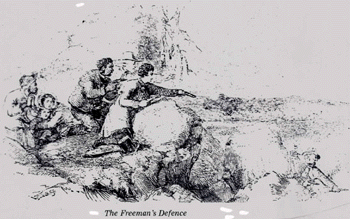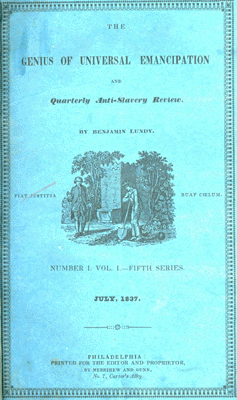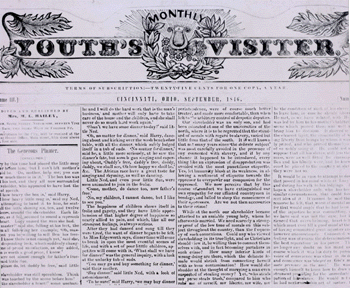Black abolitionist lecturers received perhaps even more abuse than their white counterparts. During the 1840s and 1850s, nationally prominent blacks, many of them former slaves, toured the United States and Indiana giving lectures. Frederick Douglass and Sojourner Truth were two of these famous lecturers who toured Indiana.
Douglass and a group composed of both blacks and whites came to eastern Indiana in 1843. Their reception, however, was less than cordial. "At our first meeting," Douglass wrote later of their stop in Richmond, "we were mobbed, and some of us got our good clothes spoiled by evil-smelling eggs.''1
The Free Labor Advocate, an Indiana antislavery newspaper, reprinted an article from the Wayne County Record about Douglass' visit. The Record condemned Douglass as "impudent" and termed his visit "a monstrous outrage upon the good taste of the citizens of Richmond." The editors of the Advocate recognized the irony in such comments. "For a negro to presume to tell the horrors of slavery," the Advocate retorted sarcastically, "is in the judgment of our neighbor of the Recorder a piece of impudence. . . .IMPUDENT !!"2
After their ill-fated trip to Richmond, Douglass' abolitionist entourage went to Pendleton. When they arrived, someone advised them that a pro slavery mob threatened to come to Pendleton and break up the abolitionist meeting. Though a majority of the people in Pendleton were not antislavery, they willingly listened to a discussion of the issue. The next morning the abolitionist group held a meeting in the Baptist Church at Pendleton. Douglass spoke without interruption, but a "great number of men, such as usually do not attend the meetings" were present. The church's trustees became alarmed and told William White, another member of the abolitionist party, that the group could not use the church for the afternoon session.3

The following day the abolitionists held their meeting in the woods. As they opened their meeting, a shout came from the woods and a mob of about thirty men, armed with stones and eggs, converged on the group. William White remembered the leader as "a fellow in a coon skin cap, tail and all, [who came] as a representative of the great Whig party, and another barefooted man, with nothing but a dirty shirt and pantaloons on, and the former half off his shoulders, as representation of the democracy of the country."
One of the mob cried, "Surround them." David Crowl, the man in the coon skin cap, ordered the Douglass group off; the mob accompanied Crowl's request with a "volley of eggs and stones." Dr. John Cook, an abolitionist, attempted to reason with the throng but received a reply of "copious oaths" as one of the mob told the abolitionists to "go to the South and preach." In the midst of the pandemonium, a member of the gang named "Rik" turned over the table and pulled the stand to pieces. The mob began to attack the audience, and several members of the meeting were knocked down.4
Douglass, who lost sight of William White, seized a stick and rushed into the mass. "Undertaking to fight my way through the crowd . . . I was caught up in the melee," Douglass remembered. "I attracted the fury of the mob, which laid me prostrate on the ground under a torrent of blows." The abolitionist crowd finally moved to stop the rampage, but White and several others had been injured, while Douglass lay unconscious with his hand broken. The mob dispersed and "hastily mounted their horses and rode to Andersonville, where most of them resided.''5
"I was soon up and revived by Neal Hardy, a kind-hearted member of the Society of Friends," Douglass wrote, "and carried by him in his wagon about three miles in the country to his home, where I was tenderly nursed and bandaged by good Mrs. Hardy till I was again on my feet; but, as the bones broken were not properly set, my hand has never recovered its natural strength and dexterity.''6
Douglass' reception in Newport in 1844 was quite different. "Everyone was astir early," an eyewitness remembered, "for this was 'Douglass day.' " An estimated six thousand Newport Friends, bringing their prepared food and basket dinners with them, gathered anxiously in Cowgill's grove and awaited the railroad car from which Douglass would emerge. The coach finally arrived, Douglass spoke unmolested, and the crowd received him well. He later wrote, "I honor those good men and women for their noble daring and applaud them for willingly subjecting themselves to bloody persecution by openly avowing their participation in the escape of slaves." After the Civil War, Douglass visited Indiana again; despite the fact that he had been permanently maimed in the Hoosier state, he later wrote, "We lingered long in Indiana, and the good effects of our labors there are felt at this day.''7

The Freeman's Defence
From Uncle Tom's Cabin, Volume I, facing page 284
In 1858, the abolitionist William Hayward, of Kosciusko County, described Sojourner Truth's tour of northern Indiana. In a letter to William Lloyd Garrison, Hayward claimed that "The border-ruffian Democracy of Indiana, . . . appear to be jealous and suspicious of every anti-slavery movement." According to Hayward, Hoosiers immediately circulated the rumor that Truth was a man disguised as a woman and that she was a mercenary hired by the Republican party. At one antislavery meeting, a Dr. T. W. Strain, described as a "mouthpiece of the slave Democracy," demanded that the black woman submit her breast to inspection to prove that she was not a man.
The ex-slave, a six-foot, dignified, graceful woman, arose and acquiesced. As she disrobed, she informed them that she had suckled many white babes to the exclusion of her own, and that those white babies had grown to manhood, much more manly than her persecutors. Exposing her breasts to the audience was not to her shame but to theirs. This embarrassing situation did not deter her in her abolitionist crusade. Though Truth frequently left the comfort of her home in Battle Creek, Michigan, to lecture in neighboring states, she spent much of her time "especially in Indiana, which she felt needed her missionary efforts.''8
Abolitionists also exercised their constitutional right to petition the government. Women of the Henry County Female Anti-Slavery Society frequently petitioned Congress regarding slavery. Antislavery societies and abolitionists throughout the state flooded Congress with petitions and resolutions praying that the body amend the United States Constitution to abolish slavery.9
During this time Congress and the state legislature undertook what amounted to censorship; between 1836 and 1844, Congress laid all abolitionist petitions on the table in the House chamber and refused to hear them. The institution of this practice became known as the "Gag Rule." By 1841 the state legislature began to mimic the example of Congress. The Society of Friends sent a petition to the state legislature which prayed for the enactment of a law allowing blacks the right of trial by jury when apprehended as fugitives from slavery; a committee appointed to review the petition voted to indefinitely postpone the bill. 10
Abolitionists were innovators, and they used many means to exercise their rights as citizens of the nation and Indiana. They exercised their right of free speech through the freedom of the press and the power of the written word. In 1835, when Andrew Jackson forbade the postmaster general to deliver antislavery literature in he South, northern abolitionists sent letters to sympathetic editors of southern newspapers voicing their discontent over the slavery issue. They also established newspapers of their own. In 1836 Cable Clark established an antislavery press over Levi Coffin's store in Newport. Other papers soon followed. Benjamin Stanton established the Newport Free Labor Advocate and Anti-Slavery Chronicle; there was also the Indiana Sun, The Philanthropist, The Genius of Universal Emancipation, and several others. Abolitionists even established a paper for children, The Youth Visitor.

The Genius of Universal Emancipation and
Quarterly Anti-Slavery Review
Courtesy Indiana Division, Indiana State Library
Their main vehicle, however, was through antislavery literature, including almanacs, broadsides, books, and stories.

Youth's Visitor
Showing the top of the front page
Issue courtesy Levi Coffin Association
